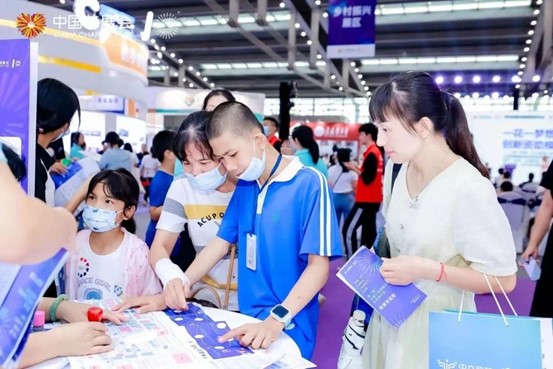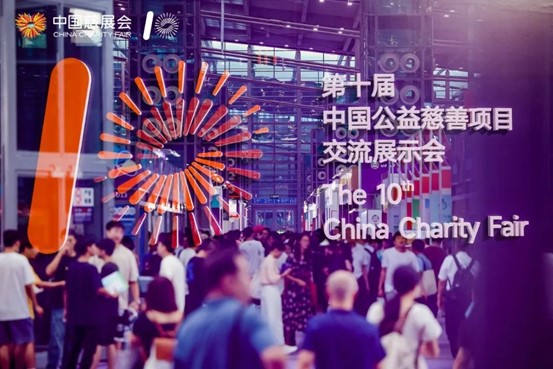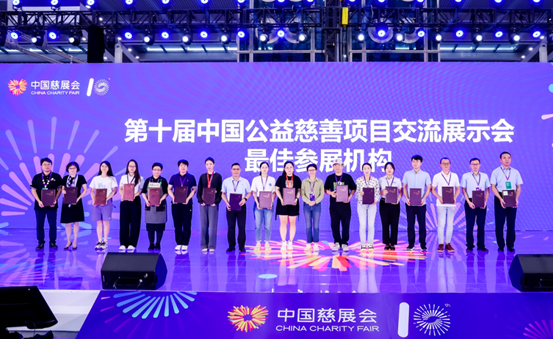'Tech for social good' may be an important booster for the development of charity in China in the future.

△ The Mascot Tour of the 10th CCF, and interactions with visitors.
The CCF, also known as the China Charity Fair, has reached its tenth session.
The 9th CCF, held in 2021, coincided with the opening year of the 14th Five Year Plan. Therefore, in close response to the policy, the theme of the exhibition was "Gathering Charity Forces to Assist Rural Revitalization". In this session, "rural revitalization" is still one of the hot spots, at the same time, closely responds to the latest requirements of Chinese path to modernization and high-quality development, and always focuses on the theme of ""Building Modern Charity, Gathering Efforts for High-Quality Development". The revision of the Charity Law and the proposal of the "third distribution" have all brought charity to a new development trend. How to measure and promote "high-quality" philanthropy? What qualities and technological capabilities does "modernization" require public welfare organizations to possess? At this exhibition, these issues have become the focus of attention.
In addition to the exchange of theoretical and practical perspectives between academia and the industry, another important significance of CCF is to showcase the high-quality project achievements in the field of charity in recent years, and provide a platform for communication and resource docking for all parties who come to the exhibition. This year, a total of 2,931 institutions and 2,882 projects participated, including charitable forces from Hong Kong, Thailand, and other domestic and foreign countries, with the funds intended for major donation projects, procurement of consumer assistance products, and industrial investment exceeding 7.9 billion yuan, which not only provides convenience for public welfare organizations and exhibitors, but also provides a window for the public to focus on understanding the development of charity and participating in public welfare actions.
Charity atmosphere permeates every community in the city
Using natural materials to handmade cattail fans and using coffee grounds to make soap, people can experience the concept of using natural materials and reducing waste while doing it. By stepping on a bicycle, one can continuously generate electricity, which encourages everyone to start paying attention to charity from the details of daily life such as transportation. And the Shenzhen Blue Sky Rescue Promotion Center has opened a small classroom on site, teaching people CPR and treatment of foreign body stuck in throat, as well as popularizing knowledge of first aid ......

△ Shenzhen Blue Sky Rescue Promotion Center popularized knowledge of first aid at the CCF.
At the Shenzhen Convention and Exhibition Center, there are a total of ten interactive experience areas, each equipped with check-in stamps. By collecting all ten stamps, one can draw a "Chuangyi Box", which is a charity blind box containing handmade items, books, agricultural products, etc. related to public welfare projects.
Compared to the previous "Cloud Exhibition" online, the 10th CCF, which has resumed offline exhibitions, hopes to maximize the utilization of the exhibition hall and even the entire urban space, thus creating a highly participatory and interesting exhibition for the visitors.
In order to attract more people to care about public welfare and participate in charity, it has set up two pavilions, the Charity High Quality Development Achievement Pavilion and the Good Life Experience Pavilion. With the figure of "10", a series of creative exhibitions have been carried out. In addition to interactive experience, this session is also accompanied by a series of brand activities such as China Charity Image Festival and TIFP New Power for Public Welfare Program. Among them, the China Charity Image Festival has collected over 600 public welfare image works from all over the country for application, and selected 128 micro films that record public welfare practices in fields such as economy, technology, and people's livelihood for promotion; while TIFP New Power for Public Welfare Program invites young public welfare people to share their innovative public welfare ideas and practical achievements, aiming to influence and promote more young people to join in public welfare activities. The video of the third season has been launched in Tencent Video, Tiktok, Bilibili and other channels.
Establishing a culture of 'charity for all' may be a common goal of various public welfare professionals and organizations. And an active and nationwide charity exhibition is clearly one of the most direct ways for charity to reach the public. Since its establishment in 2012, China Charity Fair has covered 31 provinces, autonomous regions, municipalities directly under the central government, as well as Hong Kong, Macao, and Taiwan regions in China, attracting a total of 10,663 institutions to participate. The total number of participating projects is 34,394, with a total of 1.3 million people participating in offline exhibitions. In addition, 2,620 matching projects have been completed, with a matching amount of 70.1 billion yuan.
"We pay special attention to the participation, interactivity, experiential experience, and fun of citizens at this session, and hope that citizens can continuously enhance their public welfare awareness during the participation process, "YANG Haobo, Deputy Director of the Shenzhen Civil Affairs Bureau, said in an interview with the media.

△ At the site, parents take their children to participate in check-in and stamp collection in the interactive experience area, in exchange for the "Chuangyi Box"
In addition to the main venue of the Shenzhen Convention and Exhibition Center, the 10th CCF also establishes ten sub venues for the first time, located in Futian District, Luohu District, Nanshan District, Bao'an District, and Longhua District, which showcases the unique projects of local party building leading grassroots community governance and livelihood services to a wider audience through scenes such as street party and mass service centers and street social workstations, thus allowing residents to experience the charity exhibition at their doorstep.
"This month, compassion and good deeds will become the most vibrant color of Shenzhen, allowing the charitable atmosphere of everyone being able and willing to carry out charity, and everyone being charitable to permeate various communities in the city,” YANG Haobo said that, "We also hope to further guide the power of tech for social good, so as to better serve the elderly, young, and vulnerable groups, as well as key areas of people's livelihood such as education, healthcare, employment, and ecology, thus taking the lead in establishing a demonstration highland for tech for social good nationwide, and striving to create a benchmark city for people's livelihood.
Contention of Different Thoughts for “High-quality Development”
As the "Third Distribution" was included in the report of the 20th National Congress of the Communist Party of China, promoting high-quality development of charity and common prosperity has become the theme of charity. At the 10th CCF, high-quality development has become a central topic for scholars and practitioners in the field of charity to interpret.
From the data, the charity industry in China has made significant progress. According to the China Charity Service Development Report, as of the end of 2021, the total number of social organizations in China has reached over 900,000, with 11,592 registered charitable organizations nationwide and a total of 270 million volunteers. The 29 charity organizations selected by the Ministry of Civil Affairs have attracted over 50 billion netizens to participate in public welfare charity through the Internet public fundraising information platform, with a total fundraising of over 40 billion yuan.
Talking about "high-quality development" means building on existing achievements. How to deconstruct this condensed and grand vocabulary, and how to concretely achieve this vision? The 10th CCF provides a platform for participants in charitable causes to exchange ideas through one themed seminar, 25 sub topic seminars, and multiple community roundtable discussions.
DENG Guosheng, Dean and Professor of the 21st Century Development Research Institute at Tsinghua University, who participated in the first day of the theme seminar, shared his understanding of "high-quality development" of charity with China Philanthropist. He stated that from a quantitative perspective, whether the amount of charitable donations and the number of participants in China can break through past bottlenecks and reach a new level is an important concern; From the perspective of quality, the structure of charitable resources in China still needs to be optimized, and the effectiveness of the use of donations also needs to be improved.
"At present, the charitable structure in China is not very reasonable. Sixty to seventy percent of donations come from enterprises, and only over thirty percent come from individuals. However, modern philanthropy in Europe and America relies more on individual donations. The most important significance of charity is to motivate everyone to participate, and in this regard, our personal participation level still has certain limitations." DENG Guosheng also pointed out that donations in China rely more on cash, while charity through methods such as equity donations and charitable trusts is still incomplete. "In addition, the effectiveness of our charitable resources is not good enough, and there is still room for improvement in the innovation and effectiveness of various organizations in charitable activities, which includes the cultivation of our modern charitable culture, the development of charitable organizations, and the improvement of charitable laws, regulations, and policies."

△ Visitors write their blessings and messages
ZHENG Gongcheng, a Member of the Standing Committee of the National People's Congress and President of the China Association of Social Security, who also gave a speech at the first day of the theme seminar, said that to promote the high-quality development of charity, efforts need to be concentrated on building "Chinese characteristic charity". He believes that in addition to learning from the professional models of modern charity in Europe and America, we should also attach importance to the unorganized and traditional neighborhood assistance and community charity in China.
"If following the modern standards of charity in Europe and America, the charity in China will look very pale, because family security, family and friend assistance, and neighborhood mutual assistance cannot be counted. Therefore, we must firmly establish the new concept of 'Chinese characteristic charity'", He told China Philanthropist, "We should encourage and support the development of charitable organizations that are organized, specialized, and serve non-specific beneficiaries, as well as the development of charitable activities that are unorganized, unprofessional, and serve specific beneficiaries. From a legal and policy perspective, we should be more tolerant and inclusive of all good deeds, recognize more forms of charity among the people, and laws, regulations, and policies should not override with the people."
He also mentioned that in this model, the relationship between government and charity is not the "disjointed two skins", but a collaborative entity with consistent goals and coordinated linkage. The government should increase its policy and financial and tax support for charity while conducting moderate and effective supervision, and shall strengthen service awareness, and create a social atmosphere conducive to the development of charity. Meanwhile, charity organizations should have the professional ability to self-develop and operate independently, and play their unique role.
Another important clue and force beyond the government chain is the charitable participation of enterprises. But can businesses find a logical intersection between profitability and solving social problems? The roundtable section of the main forum "Practical Exploration of Promoting High Quality Development through Business for Social Good" discusses this topic - can free competitive commerce with neoliberalism as the underlying logic inevitably achieve the result of upward for goodness?
"Previously, if the government hadn't paid attention to a social problem, businesses might not have touched it at all because it wouldn't generate benefits. Now, based on new technologies and combinations, new solutions can be explored through non-profit funds." said FU Changbo, Director of the Social Governance and Public Communication Research Center at Beijing Normal University, and Director General of the Family Inheritance and Charity Trust Committee of China Charity Federation, "It may become a new solution, or even a new business opportunity."
A typical case is the story of the "Tang Tang Quan" APP: the founder set up this diabetes exchange and mutual aid platform in 2014 because his child was found to have neonatal type 1 diabetes. It not only provides patients with management tools such as "blood sugar calendar" and social circles, but also provides doctors with patient data management, treatment plan synchronization, and patient education services, and can also promote academic research on diseases by collecting sufficient patient data.
Using mature business models and technological innovation products to solve social problems is a good way for enterprises to participate in public welfare. "The revenue of Tang Tang Quan this year can reach over 40 million yuan, which is a successful model in terms of business," FU Changbo said, "Its business model and capital investment can drive social problems that were not easy to solve before, and could even promote the improvement of public policies."

△ Exhibition site of the 10th CCF
There is a great potential for 'Tech for Social Good'
This year, another hot topic also became a focus: "Tech for Social Good". Focusing on the development of digital products and services in the field of charity, as well as the promotion of public welfare projects by technology enterprises, the exhibition features a "Tech for Social Good" exhibition area. By setting up "Tech for Social Good" application scenarios to observe and experience activities, visitors can immerse themselves in the charm of "Tech for Social Good" through close interaction. In addition, the 10th CCF also held a seminar on "Promoting High-quality Development Through Tech for Social Good" and an innovative case press conference on "Technology for Good", providing examples for more scientific and technological forces to invest in public welfare and charitable undertakings, and actively guiding social charitable resources to invest in areas such as livelihood security.
Tencent's technology public welfare series projects are representative projects that have been repeatedly mentioned and widely recognized at exhibitions. According to CHEN Yan, the initiator of Tencent Technology Public Welfare, at the seminar on "Promoting High Quality Development Through Tech for Social Good", after the country released the "Special Transformation Plan for Internet Application Aging and Accessibility" at the end of 2020, Tencent once again promoted the accessibility transformation and upgrading of its products. Taking QQ as an example, since 2009, the application has introduced features such as facial expression accessibility, OCR image and text extraction, and voiceprint plus friends for visually impaired individuals. In addition, they have launched a "caring mode" targeting the elderly population, including features such as large font size, text message reading, and voice input. They have also conducted a survey of usage difficulties among the elderly population over 60 years old, and have made global improvements and optimizations in terms of perceptibility, operability, comprehensibility, compatibility, and security.

△ The booth set up by Tencent Foundation in the "Tech for Social Good" exhibition area.
Tencent is also applying the technology it possesses to more public welfare projects. The typical representative is the "Snow Leopard AI Identification System" launched since 2021: the company recruited employees as technical volunteers, developed a set of online systems that can identify and screen snow leopards and other species in infrared camera photos, and connected with local governments and herdsmen through mountain water nature conservation centers that carry out snow leopard protection projects in Xizang and other places to support snow leopard protection. At present, the AI model has been trained with a large amount of data and can recognize 31 species, improving the accuracy of snow leopard recognition to 85.2%.
Tencent has also launched a venture capital plan for incubating technology public welfare projects, with a total of 642 projects currently being solicited in the two phases, providing start-up funds of 18.4 million yuan; In addition, a "digital toolbox" has been launched to facilitate public welfare organizations seeking digital services. Since last year's 99 Public Welfare Day, it has provided nearly 900 public welfare benefits to more than 360 institutions.
In July of this year, "Gongyi La", which joined Tencent's digital toolbox, also set up its own booth in the "Tech for Social Good" exhibition area dedicated to the venue. This is a Suzhou startup company that provides digital programming for public welfare organizations. The person in charge, HE Shouhui, introduced to China Philanthropist that in 2014, the founder of the company, who was a programmer, found that there was still a significant gap in their demand for information and digitization after coming into contact with public welfare organizations. Therefore, from the second year onwards, he officially transformed into a service provider specializing in digital development for public welfare organizations, government departments, and volunteers.
In "Gongyi La", institutions only need to provide information, select templates, and materials to quickly generate public welfare official websites. At the same time, it also provides customized development of mini programs and apps. The internal digital management, donor and donation management publicity, recipient management, volunteer and member registration management, financial management and other services required by public welfare institutions can all be clearly defined through digital methods to improve efficiency. At present, the company's products have been applied in more than 40 organizations across more than ten provinces and cities, including the Shenzhen Charity Association, Jinan Charity Association, and Suzhou Social Organization Promotion Association.
In addition, there are also technological products developed by charitable forces such as foundations participating in the exhibition. The "Zong Lan Tong Shu" app, jointly developed by the Education Foundation of Beijing Normal University, the Beijing Yifang Foundation, and the Henan Zhenyu Education Foundation, is an online picture book reading application targeted for rural schools and children. A person in charge of the Beijing Yifang Foundation introduced to reporters that rural schools can apply for an invitation system through the Beijing Normal University Foundation. After the materials are approved, they can open up free picture book reading rights for school students.
"It is the third year for us to participate in the CCF, and witnesses the first year that the product has taken shape, and is the first time that anyone has started discussing cooperation," the person in charge said. "Recently, there are a lot of people came to the booth to know about our product, including a social worker organization in Xinjiang that supports children from righteous families. They want to apply for our product."
In addition to specific public welfare products, R&D institutions are also the best embodiment of tech for social good. The "Zhijiang Laboratory", established under the leadership of the Zhejiang Provincial People's Government, supported by universities such as Zhejiang University, and constructed with the participation of enterprises, also appeared in the venue of the China Charity Fair. The Zhijiang team was established in 2017 and has collaborated with Zhejiang University and Alibaba to launch the "Tianshu" open source artificial intelligence platform, as well as China's first independently developed Braille intelligent perception device. It is reported that this innovative achievement can provide braille reading services in special education schools, libraries, and other places, as well as support the Braille accessibility function on self-service terminals such as banks and hospitals.
In addition, the 10th CCF also released a series of "Innovation Cases of Tech for Social Good" on the afternoon of the September 16th. China Huadian Group, Tencent, Kwai, Ant, Honor and many other enterprises participated in the activity and shared their achievements and experience in clean energy, new Internet public welfare model, and barrier free transformation of products.

△On the afternoon of September 17th, at the summary press conference of the CCF, the exhibitor presented a special tribute to the unit for outstanding contributions, and announced the best exhibiting organization and outstanding volunteers of this year.
Technological innovation and digital power have increasingly been injected into the field of charity, becoming a key force in promoting the modernization and professionalization of charity. "Whether the development of China's public welfare charity in the future can overtake, rapidly develop, and even catch up with the level of developed countries depends on whether charity can better utilize the power of digital technology." DENG Guosheng also expressed his concern for "tech for social good" to China Philanthropist. In his view, "tech for social good" may be a very important booster for the development of China's charity in the future. Technology companies such as Tencent are also making continuous efforts in this area. The fundamental purpose of economic development is still to improve the well-being of human life. Therefore, technology's assistance in solving social problems and promoting the development of charity is a more important and fundamental issue.